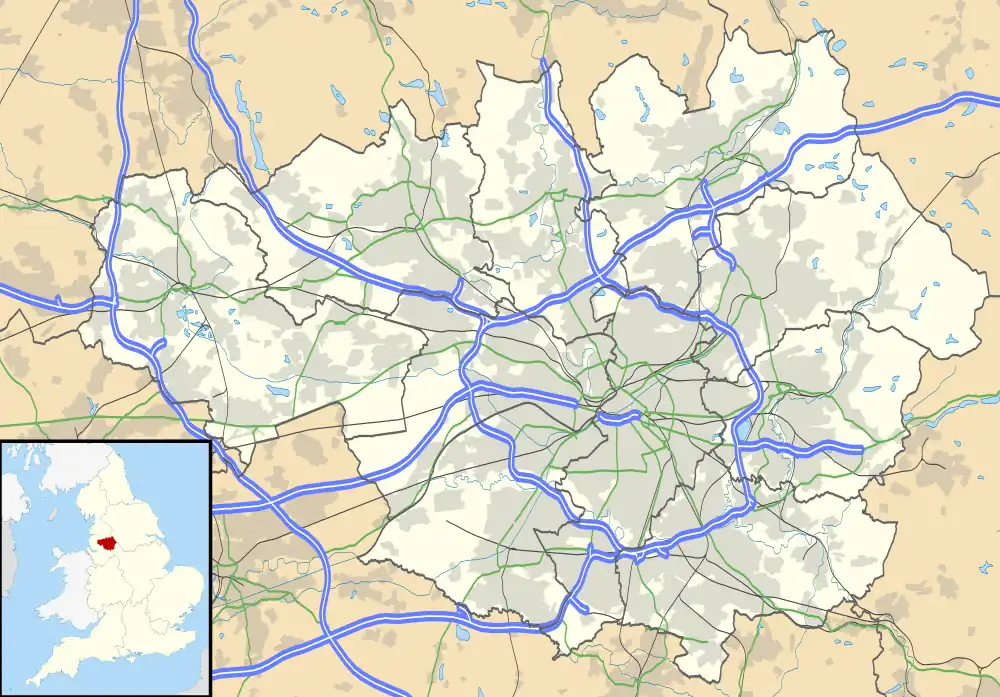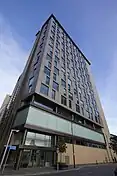| Salford Town Hall | |
|---|---|
 Salford Town Hall | |
| Location | Salford |
| Coordinates | 53°29′02″N 2°15′32″W / 53.4838°N 2.259°W |
| Built | 1827 |
| Architect | Richard Lane |
| Architectural style(s) | Neo-classical style |
Listed Building – Grade II | |
| Designated | 31 January 1952 |
| Reference no. | 1386076 |
 Shown in Greater Manchester | |
Salford Town Hall is the former town hall of Salford, Greater Manchester, England. It was the meeting place of the County Borough of Salford. Following the abolition of the county borough, it became Salford Magistrates' Court and continued to be used as such until 2011. The court was then merged with the court of Manchester to form the Manchester and Salford Magistrates' Court. The building is now in residential use and is a Grade II Listed Building being designated in January 1952.[1]
History
The foundation stone for the town hall was laid by Lord Bexley, Chancellor of the Duchy of Lancaster in April 1825.[2] The square in which the building now stands was named after him.[3] It was designed by Richard Lane in the Neo-classical style and completed in 1827.[1] The building, which was originally constructed as a market hall,[4] became the Salford's town hall in 1835 and, additionally, a courthouse in 1840.[4] The building was expanded three times in the nineteenth century.[4]
In January 1878 it was the place where local hero Mark Addy received several awards for his gallantry in saving people from drowning in the River Irwell.[5] On 1 October 1931 it was the scene of the 'Battle of Bexley Square' where 10,000 protesters of the Salford Branch of the National Unemployed Workers' Movement clashed with police, an event which is commemorated with a plaque on the building.[6][7] The novelist Walter Greenwood was present at the demonstration and a similar event is portrayed in his novel "Love on the Dole".[8]
The building became the headquarters of the County Borough of Salford and continued to be called Salford Town Hall, notwithstanding that Salford was granted city status in 1926.[9][10] It ceased to be the local seat of government when the county borough was abolished by the Local Government Act 1972[11] and Swinton and Pendlebury Town Hall became the meeting place for the enlarged local authority area, known as the City of Salford, in 1974.[12]
Salford Town Hall was used as a court house until the last two court rooms closed in December 2011.[4] It was subsequently sold to private developers, who completed converting the building into apartments in November 2015.[13]
Architecture
The building was designed by Richard Lane, and was his first architectural project. Lane would go on to design several further prominent buildings in what is now Greater Manchester, including the Friends Meeting House in Chorlton-on-Medlock and Chorlton Town Hall, both of which have similar designs to Salford Town Hall.[6] The building is constructed in the style of the Neo-classical style, with a minimalist entablature of the Doric Order. Only the front of the building is faced with stone; the sides are red brick.[1]
See also
References
- 1 2 3 Historic England. "Salford Town Hall (1386076)". National Heritage List for England. Retrieved 8 February 2019.
- ↑ Farrer, William; Brownbill, J. (1911). "'Townships: Salford', in A History of the County of Lancaster". London: British History Online. pp. 204–217. Retrieved 8 August 2020.
- ↑ Hindle, Paul (2019). Salford History Tour. Amberley Publishing. ISBN 978-1445693781.
- 1 2 3 4 Britton, Paul (9 December 2013). "Former town hall and court to be turned into apartments". Manchester Evening News. Retrieved 22 April 2020.
- ↑ Lancashire Life: A Salford Hero, April 1988
- 1 2 "Salford Town Hall". Manchester History. Retrieved 22 April 2020.
- ↑ "The Battle of Bexley Square: Salford Unemployed Workers' Demonstration". Lib.com. 1 October 1931. Retrieved 8 August 2020.
- ↑ Frow, Edmund; Frow, Ruth (13 December 2009). "The Battle of Bexley Square". libcom.org. Retrieved 1 October 2021.
- ↑ Beckett, J V (2005). City status in the British Isles, 1830–2002. Historical urban studies. Aldershot: Ashgate. ISBN 0-7546-5067-7.
- ↑ "No. 33154". The London Gazette. 23 April 1926. pp. 2776–2777.
- ↑ "Local Government Act 1972". Legislation.gov.uk. Retrieved 22 April 2020.
- ↑ "Civic Centre history". Salford City Council. Retrieved 22 April 2020.
- ↑ "Salford Town Hall". Bardsley. Retrieved 22 April 2020.




